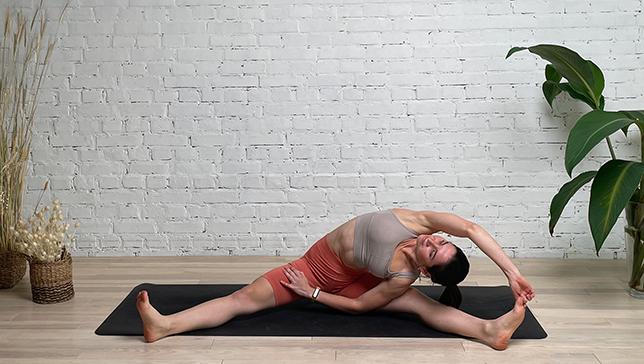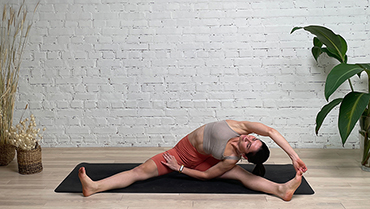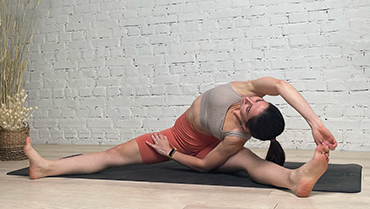Revolved Seated Wide Angle Pose - Parsva Upavistha Konasana

Contents
Revolved Seated Wide Angle Pose, Side Seated Wide Angle Pose or Parsva Upavistha Konasana in Sanskrit, is a wide-legged seated asana where the torso folds forward over each leg, one at a time. The name comes from the Sanskrit, parsva, meaning “side,” upavistha, meaning “seated,” kona meaning “angle,” and asana, meaning “pose.”
This is a twisted variation of the traditional seated asana. Parsva Upavistha Konasana can be used as part of a hip-opening sequence, following a standing sequence, or incorporated into a forward bend sequence.
Keep your thighs and sit bones grounded as you twist from your navel and work deeper into the back ribs. As you breathe, focus on the feeling of extension in the side of your ribcage.
Pose Detail
- By Type: Chest Opening Yoga Poses, Flexibility Yoga Poses
- Difficulty: Intermediate
- Body Position: Lateral Bend Yoga Poses, Seated Yoga Poses
Step-by-Step Instructions
Benefits and Contraindications
Calms the mind.
Relieves stress, fatigue and insomnia.
Stretches the hips, hamstrings, oblique muscles.
Lengthens the spine.
Slipped disc
Severe leg, hip or arm injuries.
Hernia
Sciatica
Photo poses in different angles


Modification
Keep knees slightly bent, keep elevated arm overhead instead of touching toes, place blanket under hips or heels, place bolster or several blankets between legs and torso.
Tips
Lengthen the spine and chest along the extended leg. Over time this will extend the abdominal area and allow more space for breathing.
The leg that your extending away from has a tendency to turn inward. You may allow this or rotate it outwards so that the knee faces upwards perfectly. The positioning and rotation of the leg affects the adductor muscles many of which are large muscles attaching to the pelvis and inner part of the femur bone.
Frequently Asked Questions
Variations
- Wide Angle Seated Forward Bend Pose
- Side Seated Wide Angle Pose Arm Up
- Revolved Head to Knee Pose
Top Preparatory Poses
- Standing Side Stretch Pose
- Intense Leg Stretch Pose (Standing Wide-Legged Forward Fold Pose)
- Gate Pose
- Wide Angle Seated Forward Bend Pose